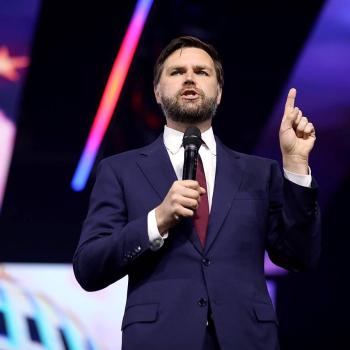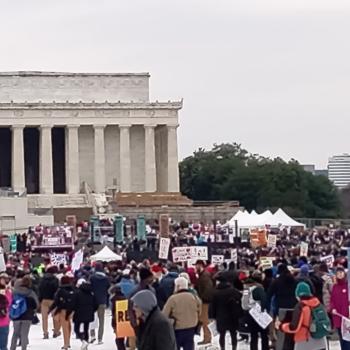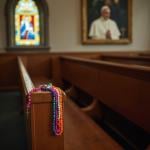Rory Cooney, on his blog Gentle Reign, published the following comment from a friend of his:
In some ways, I see this attraction to the Tridentine (rite) as a rejection of the messiness of incarnation. The idea that we’re celebrating the Mass that Jesus said, untouched by 2000 years of history. The idea that “the Mass is the same, no matter where you go” avoids dealing with the particular culture and history and quirkiness of whatever physical place one happens to be. We all face God together, so that we can turn our backs on the world, forgetting that we are at Mass precisely so that we can go out and proclaim the Kingdom to that very specific, messy, incarnate world. This longing for “the Transcendent” is for me a rejection of the fact that when God desired to have his people experience his love in the most powerful way possible, he sent a particular (God)man, to be born in a particular place, of a specific woman, at a particular time, who spoke a particular language, all of which had all the messiness of particularity that goes with history and culture. Human beings simply do not exist apart from that history and culture, and it is a delusion that we can escape that worldly groundedness in our prayer. As long as I can fix my gaze on the wonder of the Transcendent God, I don’t have to pay attention to the person sitting in the pew next to me, in whom Christ dwells, and whom Christ calls me to love.
The fact of the Incarnation means that when we go to Mass, we do have to deal with this particular presider (bad preaching and all), this particular lector, that cantor who drives me crazy, the six kids in the pew in front of me, the obnoxious usher, etc. etc., and try to encounter Christ in and through them. And if I can’t (or won’t) do that at Mass, how in God’s name will I be able to do it out in the (all too messy, incarnate) world?
Now, before the fireworks start, let me acknowledge that this is a rant, and probably a one-sided one. Defenders of the traditional liturgy (several of whom are regulars in our commboxes here): feel free to respond, but try to do so thoughtfully. Opponents of the traditional liturgy: no cheap shots, please.
However, beyond questions of liturgical practice, I posted this comment here because I think it encapsulates two approaches to Catholic identity, and in some way encapsulates the differences between Pope Benedict and Papa Francisco. Benedict, the austere intellectual, started with the timeless truths of faith, and slowly, unevenly, worked his way back to the world. His conclusions were powerful: anyone reading his two encyclicals will find in them a thorough critique of the modern world. But my sense, perhaps inaccurate, is that while he wanted to bring the world to Christ, he was not willing to step into the world to catch it. He was like the priest who stands on the top altar step to distribute communion: there, accessible, ready to give the Body of Christ, but also positioned above the masses coming to him.
Francisco, on the other hand, embraces the Incarnate Christ by embracing the world in all its messiness, confusion and even danger. On the drive from the airport in Rio the crowd was going wild, papal security was on high alert, and the prelates with him and watching on television were clearly on the verge of panic. (See for instance, NCR’s interviews with Chaput and Dolan.) Franciso, on the other hand seemed to be in his element: smiling, waving, kissing and blessing the children handed up to him. I am reminded of the passages in the gospels where the crowds pressed close around Jesus, to the discomfiture of the disciples but not of Jesus. In the same way, Francisco ventured into the favelas of Rio as he previously went into the slums of Buenos Aires: not to scold, not to preach, not to engage in a liberal guilt trip, but to embrace its inhabitants, in all their messy particularity.
In this he is following the example of St. Francis of Assisi. While to his later biographers the prayer before the Crucifix was central to Francis’ conversion, Francis himself felt that his conversion came when he embraced the crucified in the world around him:
This is how the Lord gave me, brother Francis, the power to do penance. When I was in sin the sight of lepers was too bitter for me. And the Lord himself led me among them, and I pitied and helped them. And when I left them I discovered that what had seemed bitter to me was changed into sweetness in my soul and body. (Testament, 1)
So to bring this discussion full circle to the liturgy: as we discussed in a previous post, the liturgy plays a very important role in catechesis. How then, should the liturgy be shaped to bring the sense of the Incarnation to the foreground, so that those who participate in the mass are renewed and better able to see Christ not only in the Eucharist, but in the pews around them and in the world they go into on Monday morning? How can we equip ourselves to step out of the Church and bring the love of Christ to a world that desperately needs it, but to which we have, far too often, failed to make it manifest? Is the comment above correct that the Tridentine liturgy distances us from the Incarnation by its focus on transcendence?
















